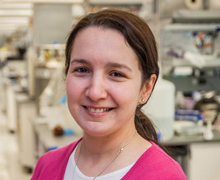Characterizing Genetically Linked Brain Malformations
Using Next Generation Sequencing to trace the genetic basis for brain malformations linked to PI3K-AKT-MTOR dysfunction
Technology Overview
With recent advances in genetic sequencing techniques, there has been a surge in understanding human developmental brain disorders rooted in the dysregulation of genetic pathways that control tissue growth and maturity. Several pathways leading to brain abnormalities in children have been implicated in adult cancers, necessitating the in depth characterization of the genetic modes by which these brain disorders develop, with morbidities including brain growth abnormalities, malformations of cortical development, autism and epilepsy.
 Dr. Ghayda Mirzaa
Dr. Ghayda Mirzaa
Work conducted by Dr. Mirzaa has focused on elucidating the role of the PI3K-AKT-MTOR pathway and characterizing its up and downstream signaling cascade in relation to brain disorders. Specific disease areas of interest to Dr. Mirzaa include megalencephaly, focal cortical dysplasia, and hydrocephalus. Significant findings from Dr. Mirzaa’s past work have led to the characterization of four genes associated with megalencephaly (CCND2, PIK3CA, PIK3R2, and AKT3) and two others linked to microcephaly (CENPE and STAMBP). Ongoing work focuses on characterizing both the genotypic causes and phenotypic expression of brain disorders through use of Next Generation Sequencing (NGS) techniques. Additionally, special emphasis is placed on the detection of low frequency genetic variation and pathway dysregulation using high throughput genomic, transcriptomic, and proteomic methods to facilitate molecularly targeted therapeutic trials.
While Dr. Mirzaa is predominantly focused on the role of PI3K-AKT-MTOR in brain malformation, this pathway has implications in much broader disease areas, including metabolic and cardiac disorders. Dr. Mirzaa has previously helped validate novel inhibitors developed by industry for this pathway, and is interested in continuing work such as this. Additionally, Dr. Mirzaa’s work has led to the collection of an extensive bio repository of brain tissue samples from patients with a multitude of brain disorders, which she is interested in leveraging as a tool in developing new diagnostics and validating pharmaceutical targets.
Dr. Ghayda Mirzaa’s Faces of Research Video
Stage of Development
- Pre-clinical in vitro
- Pre-clinical ex vivo
Partnering Opportunities
- Collaborative research opportunity
- Development opportunity
- Sponsored research agreement
- Consultation agreement
- Tissue sample access
Publications
- Pirozzi F, Nelson B, Mirzaa G. From microcephaly to megalencephaly: determinants of brain size. Dialogues Clin Neurosci. 2018 Dec;20(4):267-282. Review. PubMed PMID: 30936767; PubMed Central PMCID: PMC6436952.
- Dobyns WB, Mirzaa GM. Megalencephaly syndromes associated with mutations of core components of the PI3K-AKT-MTOR pathway: PIK3CA, PIK3R2, AKT3, and MTOR. Am J Med Genet C Semin Med Genet. 2019 Aug 23. doi: 10.1002/ajmg.c.31736. [Epub ahead of print] PubMed PMID: 31441589.
- Michels S, Foss K, Park K, Golden-Grant K, Saneto R, Lopez J, Mirzaa GM. Mutations of KIF5C cause a neurodevelopmental disorder of infantile-onset epilepsy, absent language, and distinctive malformations of cortical development. Am J Med Genet A. 2017 doi: 10.1002/ajmg.a.38496. [Epub ahead of print]
- Alcantara D, Timms AE, Gripp K, …. Mirzaa GM. Mutations of AKT3 are associated with a wide spectrum of developmental disorders including extreme megalencephaly. Brain. 2017; 140: 2610-2622.
- Mirzaa G, Campbell C, Solovieff N et al. Association of MTOR mutations with developmental brain disorders, including megalencephaly, focal cortical dysplasia, and pigmentary mosaicism. JAMA Neurology. 2016;73: 836-845.
- Mirzaa G, Conti V, Timms A et al. Characterisation of mutations of the phosphoinositide-3-kinase regulatory subunit, PIK3R2, in perisylvian polymicrogyria: a next-generation sequencing study. The Lancet Neurology. 2015;14(12):1182-1195.
- Mirzaa G, Parry D, Fry A et al. De novo CCND2 mutations leading to stabilization of cyclin D2 cause megalencephaly-polymicrogyria-polydactyly-hydrocephalus syndrome. Nature Genetics. 2014;46(5):510-515.
Learn More
To learn more about partnering with Seattle Children’s Research Institute on this or other projects, email the Office of Science-Industry Partnerships.
